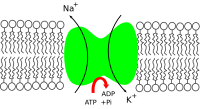
Back صوديوم في علم الأحياء Arabic El sodio en la biología Spanish Natrium dalam biologi Malay Natrijum u biologiji Serbian Натрій у біології Ukrainian

Sodium ions (Na+) are necessary in small amounts for some types of plants,[1] but sodium as a nutrient is more generally needed in larger amounts[1] by animals, due to their use of it for generation of nerve impulses and for maintenance of electrolyte balance and fluid balance. In animals, sodium ions are necessary for the aforementioned functions and for heart activity and certain metabolic functions.[2] The health effects of salt reflect what happens when the body has too much or too little sodium. Characteristic concentrations of sodium in model organisms are: 10 mM in E. coli, 30 mM in budding yeast, 10 mM in mammalian cell and 100 mM in blood plasma.[3]
Additionally, sodium ions are essential to several cellular processes. They are responsible for the co-transport of glucose in the sodium glucose symport, are used to help maintain membrane polarity with the help of the sodium potassium pump, and are paired with water to thin the mucus of the airway lumen when the active Cystic Fibrosis Transport Receptor moves chloride ions into the airway.[4]
- ^ a b Furumoto, Tsuyoshi (24 Aug 2011). "A plastidial sodium-dependent pyruvate transporter". Nature. 476 (7361): 472–475. Bibcode:2011Natur.476..472F. doi:10.1038/nature10250. PMID 21866161. S2CID 205225645.
- ^ Pohl, Hanna R.; Wheeler, John S.; Murray, H. Edward (2013). "Chapter 2. Sodium and Potassium in Health and Disease". In Astrid Sigel, Helmut Sigel and Roland K. O. Sigel (ed.). Interrelations between Essential Metal Ions and Human Diseases. Metal Ions in Life Sciences. Vol. 13. Springer. pp. 29–47. doi:10.1007/978-94-007-7500-8_2. ISBN 978-94-007-7499-5. PMID 24470088.
- ^ Milo, Ron; Philips, Rob. "Cell Biology by the Numbers: What are the concentrations of different ions in cells?". book.bionumbers.org. Retrieved 8 March 2017.
- ^ Cite error: The named reference
:1was invoked but never defined (see the help page).